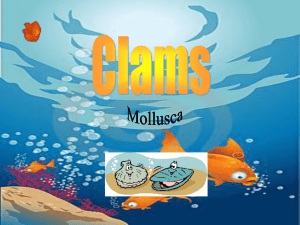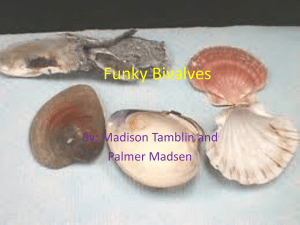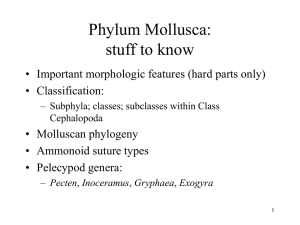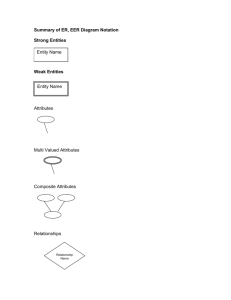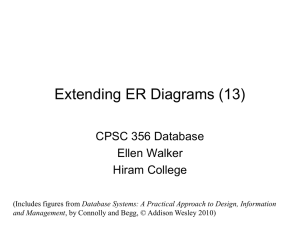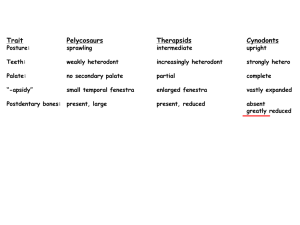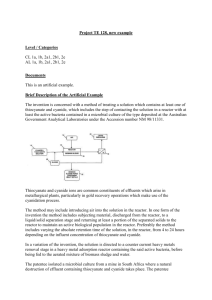Class Bivalvia (Pelecypoda)
advertisement
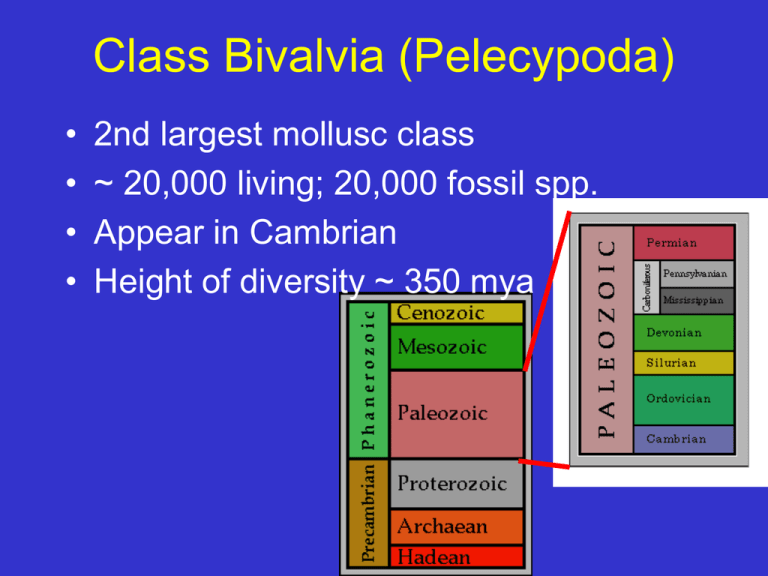
Class Bivalvia (Pelecypoda) • • • • 2nd largest mollusc class ~ 20,000 living; 20,000 fossil spp. Appear in Cambrian Height of diversity ~ 350 mya Class Bivalvia (Pelecypoda) • Sizes: 2 mm to > 1.35 m (Tridachna gigas, giant clam can weigh 440 lbs.) • 1. Bivalve shell • 2. Bilateral symmetry, body compressed laterally • 3. Rudimentary head, no eyes, no tentacles, no radula Characters, cont. • 4. Large blade-like foot • 5. Pair of large, complex, ciliated gills – Filter feed on plankton, sediments • 6. Some sessile species have byssal threads for attachment to substrate – Mussels and oysters – Secreted by gland at based of foot Bivalves • 7. Most are dioecious • External fertilization, or in mantle chamber (some marine and most freshwater spp.) • 8. Marine species: trochophore + veliger larvae present – Freshwater Unionacea veliger = glochidia • Parasitic on fish gills • Fishes are host to glochidia Subclass Protobranchia • Primitive, small, marine bivalves • Nut clams Nucula yoldia • Cryptodont Solemya 0.45 cm 1.5 cm Subclass Lamellibranchia 98% of bivalves • A. arks, Arca – Hinge straight w/ numerous fine, regular teeth – Bitter sweet clams, Glycemeris Subclass Lamellibranchia • B. Mussels, winged or tree oysters, pen shells – Byssal threads for attachment – Mytilus, Modiolus are edible mussels – Pearl oysters Pinctada are winged oysters Subclass Lamellibranchia • C. Scallops Pectin, jingle shells, file shells – Scallops swim by clapping their valves – Numerous blue eyes on mantle margin Subclass Lamellibranchia • D. Oysters Osstrea, Crassostrea (Asian) – Form large attached colonies – Oyster farming began over 100 years ago in U.S. Subclass Lamellibranchia • E. Unionacea, freshwater clams • Small commercial fishery in Indiana and elsewhere in U.S. produced “mother of pearl” • Currently for Japanese pearl industry You are required to know: Megalonaias nervosa = washboard Amblema plicata = three ridge Quadrula metanevra = monkeyface Elliptio crassidens = elephant ear Obovaria subrotunda = hickorynut Corbicula fluminea = Asian clam Megalonaias nervosa = washboard Amblema = three-ridge Quadrula metanevra = monkeyface Elliptio crassidens = elephant ear Obovaria subrotunda = hickorynut Corbicula fluminea = Asian clam Subclass Lamellibranchia • F. Lucines, jewel boxes, and cockles • Cockles are edible and popular in Europe, Cardium Subclass Lamellibranchia • G. Giant clams, Tridachna are tropical sessile species • Rely on commensal algae for much of nutrition • Most species are endangered in many areas by shell collectors Subclass Lamellibranchia • H. Sphaeridae: freshwater fingernail clams • Corbicula, Asian clams • Common, most < 1/4 inch Subclass Lamellibranchia • I. Razor clams - elongate valves • J. venus clams – Mercenaria is the tasty cherrystone or hard-shelled clam Subclass Lamellibranchia • K. Soft-shell clams (in comparison with Mercenaria) – Mya is commercial clam in U.S. – Geoducks – Panopea Corbicula fluminea, Asian clam • Corbiculidae • Hermaphroditic • Introduced to North America early 1900’s • Widespread E., S., and far W. United States Corbicula • Life history adapted for unstable, unpredictable habitats • Highly invasive, replaces native Sphaeriid populations – Highest filtration and assimilation rates of any freshwater bivalve – Highest growth and production rate – 3-6 mos. to maturity – Single adult can produce 68,678 juv/year Dreissena spp., zebra mussel and quagga mussel • Widespread colonial, sessile bivalve from Europe – Caspian Sea • Spread through European drainages in 1700’s Zebra and quagga mussels • 1985 - Lake St. Claire by ship water ballast • 1990 - entire Great Lakes and St. Lawrence • Continues to spread through rivers Zebra and quagga mussels • • • • Tend to foul pipes - industry, boats, etc. Dioecious, trochophore and veliger larvae Adults attach by byssal threads Very small eggs, – 30,000 - 40,000 per female – Kill natives by overcolonization Boring clams (Pholas) and shipworms (Teredo) • Shipworms cause economic damage by boring in pilings and submerged wooden structures Subclass Septibranchia • Watering pot shells • Elongate tube-shaped with tiny shells • Live in mud or bore in rock, coral, or clamshells Class Cephalopoda - octopus and squids • Extremely complex, advanced molluscs • Nervous and sensory system development surpasses all other invert’s • ~ 1000 extant spp. • ~ 10,500 fossil spp. • Appear in Cambrian – Peaks in abundance Paleozoic + Mesozoic Cambrian = 500 mya present 250 mya 65 mya 65 mya 250 mya 550 mya Class Cephalopoda - octopus and squids • Largest invertebrate animal is giant squid of North Atlantic (Architeuthes) – to 16 m with long arms • All marine + carnivores Characteristics: • 1. Primitively - straight or coiled shell divided into compartments by septa – Shell used for buoyancy – Many cephalopod shells are reduced or absent – Compartments connected by siphuncle • Secretes or absorbs nitrogen-rich gas into chambers – New chambers secreted w/growth Characters • 2. Bilateral symmetry • 3. Well-developed head w/prominent, welldeveloped eyes • Eyes resemble vertebrate eyes • 4. Prehensile tentacles - derived from anterior of foot - suckers (except Nautilus) Characters • 5. Dorsal-ventral axis of body has become functional posterior-anterior axis, by elongation • 6. Mantle encloses body – Thick and muscular – Opening to cavity is funnel-shaped siphon – Pump water out for backwards “jetpropulsion” Characters • 7. Mouth equipped with pair of chitinous jaws - resemble hawk’s beak – Radula present • 8. Respiration- pair of gills in mantle cavity. – No cilia • 9. Ability to change skin color by melanophores in most spp. Characters • 10. Brain large + complex. – Behavior and learning highly developed • 11. Dioecious: copulation by transfer of spermatophore by one of tentacles • 12. Egg development direct - no larva Classification • 1. Subclass Nautiloidea – Nautiloids, shelled – Living Nautilus with 3? spp. • Indo-Pacific – Many fossil species – Don’t confuse with “paper nautilus” - an octopus 2. Subclass Ammonidea Ammonoids • Shell w/ complex sutures • Silurian - Cretaceous 3. Subclass Coleoidea - shell internal or absent • A. Belemnites - extinct, w/chambered internal shell. Probably ancestral to other coleoids • B. Spirula - coiled chambered internal shell. – Deep-water denizen of tropics Subclass Coleoidea • C. Cuttlefish – straight, chambered, internal shell – Sepia – Rossia (bob-tailed squid) D. Squids • Shell chitinous, no chambers, serves as body skeleton • Many pelagic and deep-sea spp.; few in shallow waters • Loligo • Lolliguncula • Architeuthes E. Vampire squid • Octopus-like forms with webbed arms • Vampyroteuthis infernalis • Black skin F. Octopods • Eight arms, no fins • Octopus • Argonauta (produces shell-like eggcase, has dwarf males) It appears that: • Molluscs have evolved from ancestors of flatworms by acquisition of: – 1. Complete gut – 2. A shell – 3. “body cavity” (elements of circulatory system spaces) – See online Mollusca Phylogeny paper

